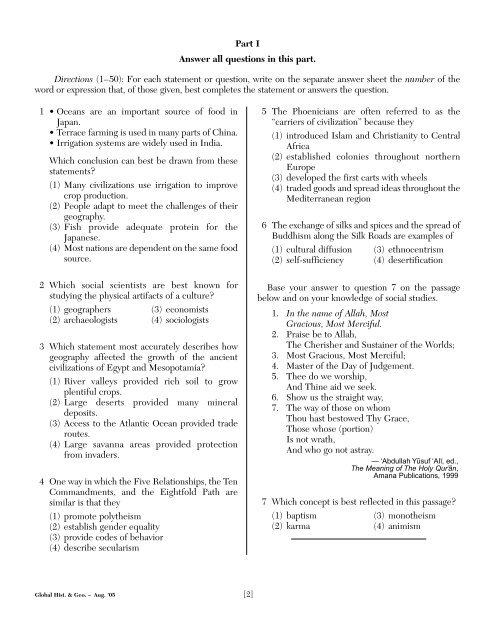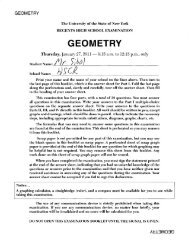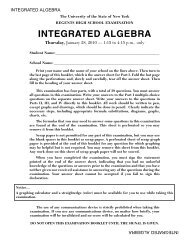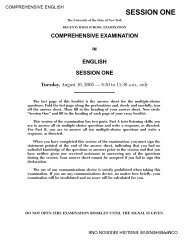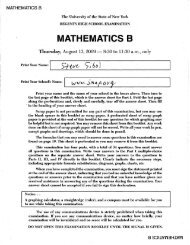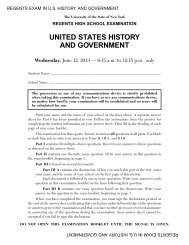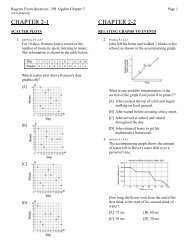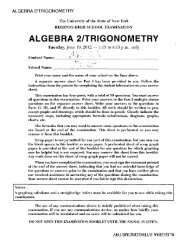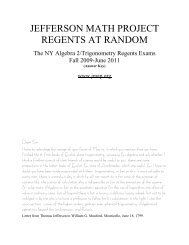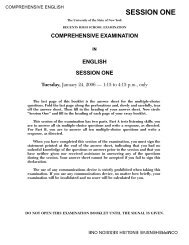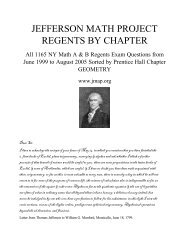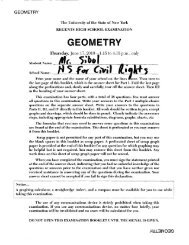global history and geography - JMap
global history and geography - JMap
global history and geography - JMap
Create successful ePaper yourself
Turn your PDF publications into a flip-book with our unique Google optimized e-Paper software.
Part I<br />
Answer all questions in this part.<br />
Directions (1–50): For each statement or question, write on the separate answer sheet the number of the<br />
word or expression that, of those given, best completes the statement or answers the question.<br />
1 • Oceans are an important source of food in<br />
Japan.<br />
•Terrace farming is used in many parts of China.<br />
• Irrigation systems are widely used in India.<br />
Which conclusion can best be drawn from these<br />
statements?<br />
(1) Many civilizations use irrigation to improve<br />
crop production.<br />
(2) People adapt to meet the challenges of their<br />
<strong>geography</strong>.<br />
(3) Fish provide adequate protein for the<br />
Japanese.<br />
(4) Most nations are dependent on the same food<br />
source.<br />
5 The Phoenicians are often referred to as the<br />
“carriers of civilization” because they<br />
(1) introduced Islam <strong>and</strong> Christianity to Central<br />
Africa<br />
(2) established colonies throughout northern<br />
Europe<br />
(3) developed the first carts with wheels<br />
(4) traded goods <strong>and</strong> spread ideas throughout the<br />
Mediterranean region<br />
6 The exchange of silks <strong>and</strong> spices <strong>and</strong> the spread of<br />
Buddhism along the Silk Roads are examples of<br />
(1) cultural diffusion (3) ethnocentrism<br />
(2) self-sufficiency (4) desertification<br />
2 Which social scientists are best known for<br />
studying the physical artifacts of a culture?<br />
(1) geographers (3) economists<br />
(2) archaeologists (4) sociologists<br />
3 Which statement most accurately describes how<br />
<strong>geography</strong> affected the growth of the ancient<br />
civilizations of Egypt <strong>and</strong> Mesopotamia?<br />
(1) River valleys provided rich soil to grow<br />
plentiful crops.<br />
(2) Large deserts provided many mineral<br />
deposits.<br />
(3) Access to the Atlantic Ocean provided trade<br />
routes.<br />
(4) Large savanna areas provided protection<br />
from invaders.<br />
4 One way in which the Five Relationships, the Ten<br />
Comm<strong>and</strong>ments, <strong>and</strong> the Eightfold Path are<br />
similar is that they<br />
(1) promote polytheism<br />
(2) establish gender equality<br />
(3) provide codes of behavior<br />
(4) describe secularism<br />
Base your answer to question 7 on the passage<br />
below <strong>and</strong> on your knowledge of social studies.<br />
1. In the name of Allah, Most<br />
Gracious, Most Merciful.<br />
2. Praise be to Allah,<br />
The Cherisher <strong>and</strong> Sustainer of the Worlds;<br />
3. Most Gracious, Most Merciful;<br />
4. Master of the Day of Judgement.<br />
5. Thee do we worship,<br />
And Thine aid we seek.<br />
6. Show us the straight way,<br />
7. The way of those on whom<br />
Thou hast bestowed Thy Grace,<br />
Those whose (portion)<br />
Is not wrath,<br />
And who go not astray.<br />
— ‘Abdullah Yūsuf ‘Al¯l, ed.,<br />
The Meaning of The Holy Qur’ān,<br />
Amana Publications, 1999<br />
7 Which concept is best reflected in this passage?<br />
(1) baptism (3) monotheism<br />
(2) karma (4) animism<br />
Global Hist. & Geo. – Aug. ’05 [2]


